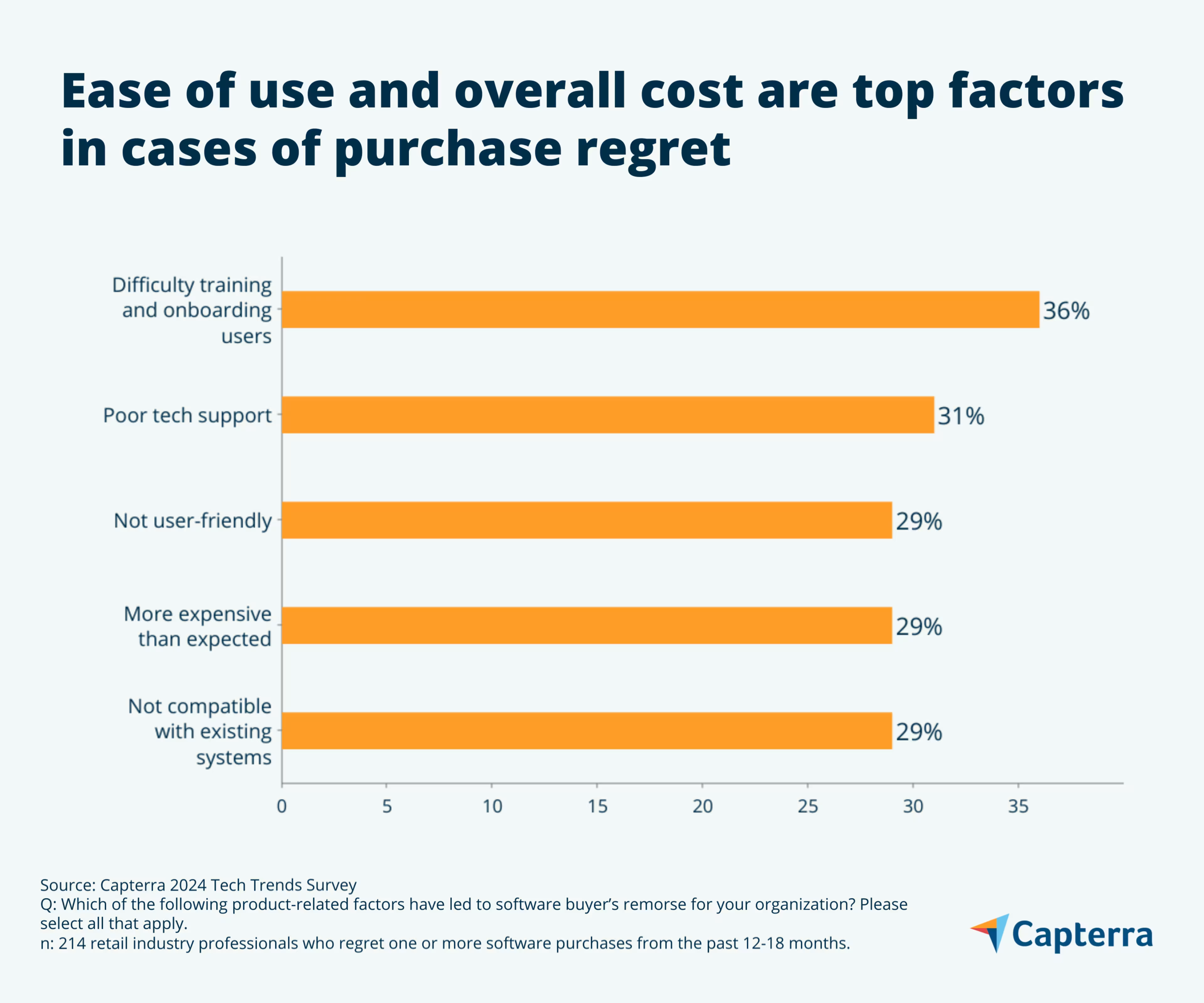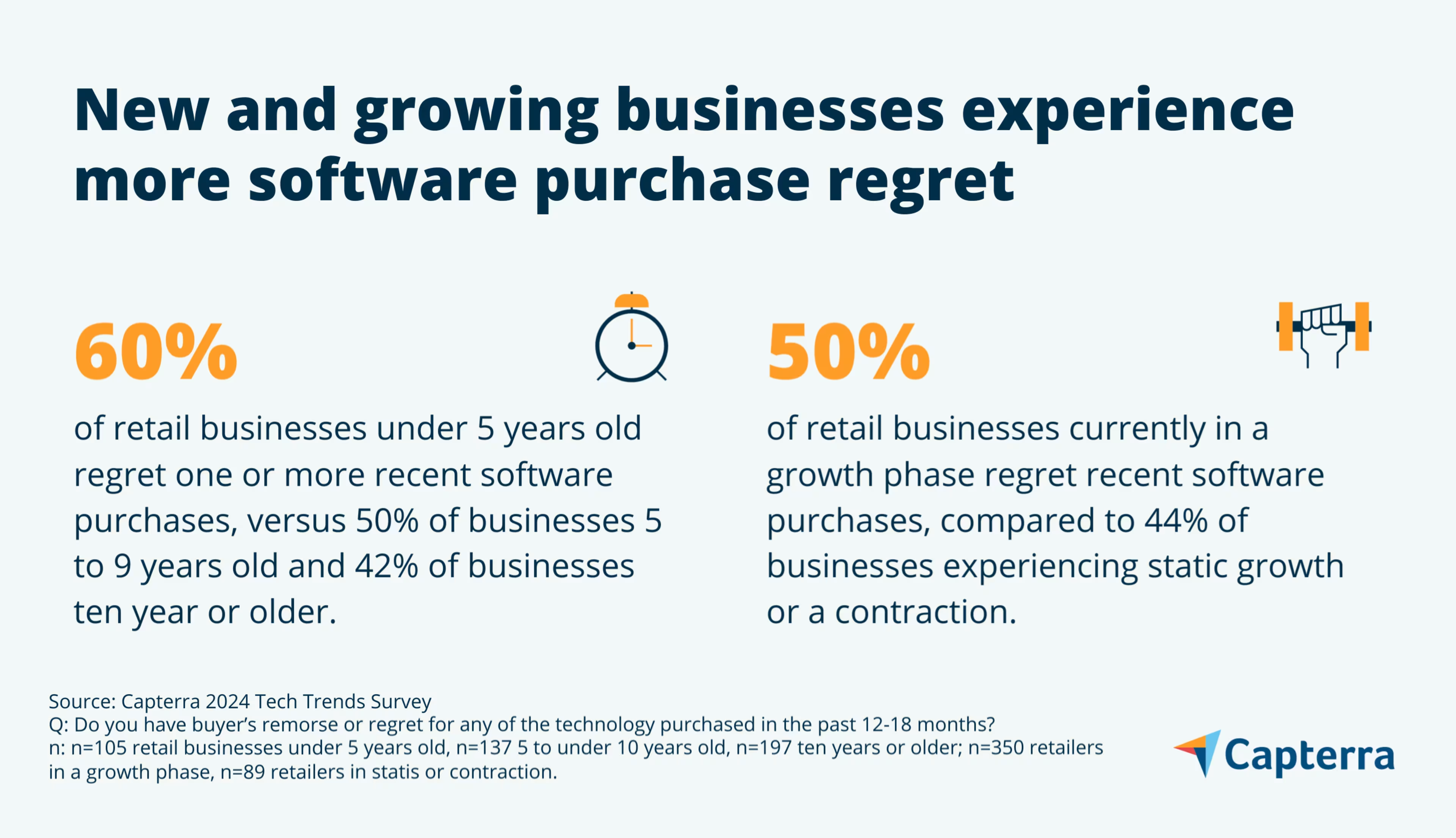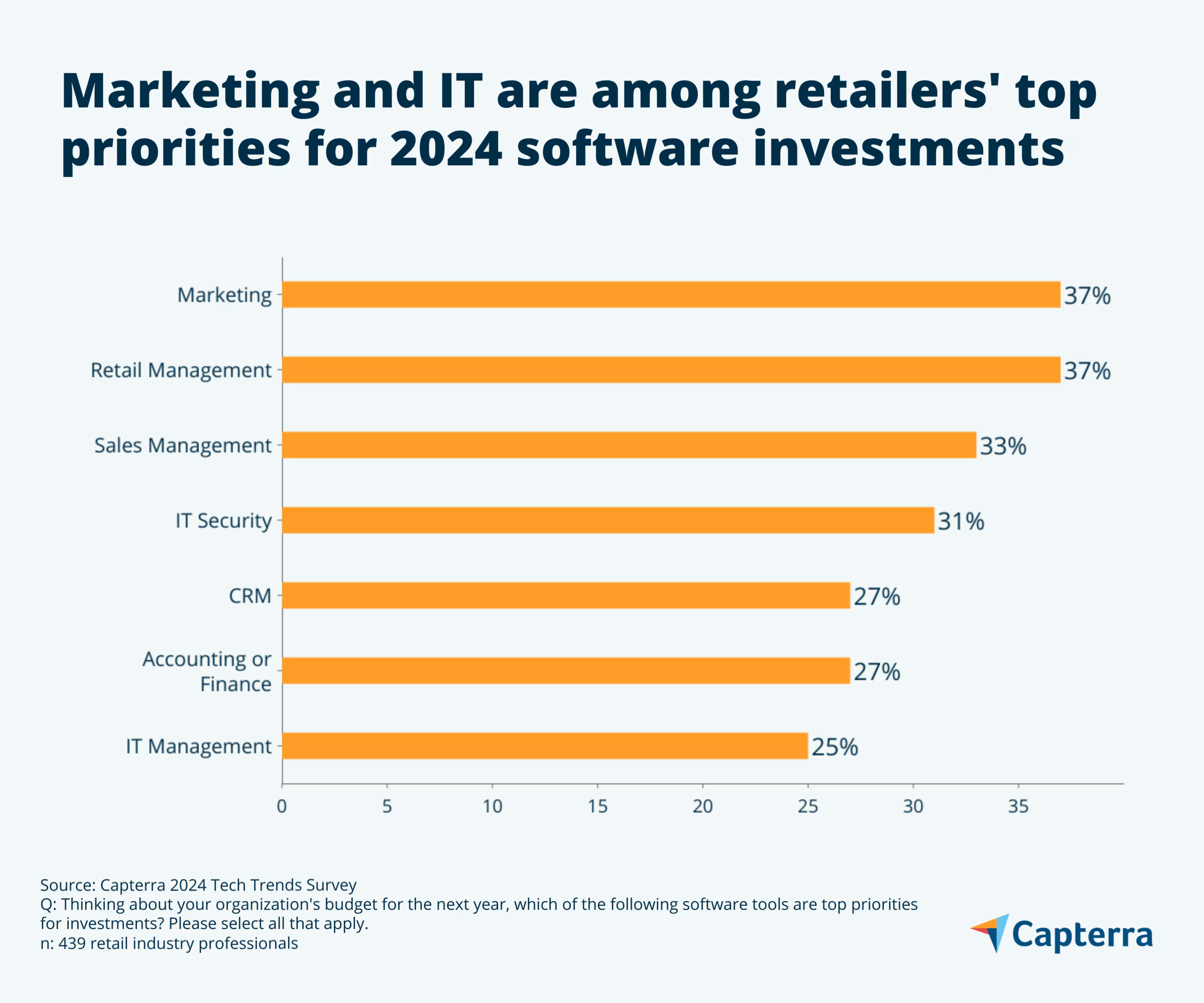Aligning stakeholders on goals and budget can help prevent regret.
Capterra’s 2024 Tech Trends Survey shows that too many retailers are falling victim to software buyer’s regret—in fact, nearly half of retailers globally regret one or more software purchases from the past year.*
By analyzing major trends emerging from the buying strategies and hindsight recommendations of more than 400 retail industry professionals, you can take the necessary steps to ensure your next software purchase lives up to your expectations.
/ Key findings
Software regret has a significant impact on nearly half of retailers: 49% of retailers regret one or more software purchases from the past 12 to 18 months.
Retailers are prioritizing a (secure) online presence: Retailers will focus their new software investments on marketing, retail management, and IT security needs.
57% of retailers plan to spend more on software in 2024: Clarifying goals for new technology early and creating a shortlist of vendors helps avoid purchase regret.
Trend #1: 49% of retailers regret one or more software purchases made in the past year and a half
Nearly half of retailers who invested in software last year ended up regretting their purchase, with close to one in four regretting multiple purchases. The incidence of buyer’s remorse is lower for retailers than for other industries, such as education, transportation, and construction. But it’s still a significant problem affecting just under half of the entire industry—and one that can be averted with preventive action.
Most often, retailers experiencing buyer’s regret find fault with the software they purchased, rather than with the vendor they bought it from. That said, the most common vendor-related causes of dissatisfaction—in a nutshell, poor tech support—can create or make problems worse with any product.

Take ease of use, for example. Nearly one-third of retailers that regret their most recent software purchase said the software was not user-friendly. Some software takes a bit of trial and error to get the hang of, but the last thing you want when navigating a confusing new product is a vendor whose support desk takes days to respond or offers few to no onboarding resources to begin with.
Retailers across demographics are vulnerable to regrettable purchases. However, newer and growing businesses are more likely to regret their investments (60% and 50%, respectively) compared to businesses over a decade old or those experiencing either static or negative growth (42% and 44%, respectively).

A growth phase is an exciting time for a retailer, whether it means expanding your brick-and-mortar footprint, launching new products, or capitalizing on a viral social media campaign. You may feel the need to invest in new software quickly to support expanding operations and while it can be tempting to rush toward your next tech solution, remember that it takes time and research to ensure you don’t end up regretting your purchase.
64% of retailers who regret a recent software purchase rate the impact of that purchase as significant to monumental
The fallout from regrettable software purchases is significant and far-reaching. Not only a waste of money, regrettable purchases cause daily frustration for the employees who dislike using the software, which impacts productivity and, ultimately, competitiveness in the market.

Businesses that regret one or more of their 2023 purchases also plan to spend more on software in 2024—in other words, a bad software purchase could haunt you, as you may need to quickly replace it with an alternative.
/ Key takeaway
There’s a common theme on both the product and vendor sides of a regrettable purchase: Dissatisfaction arises when it’s harder than anticipated to onboard, use, or troubleshoot new software. Retailers can avoid this issue by working with vendors that offer robust onboarding and implementation support and have a proven track record of fast support desk response times. Reading reviews from other customers, asking questions specifically about support in your purchase negotiations, and testing vendors’ responsiveness during trial periods can help you find a vendor that offers the level of interaction that’s right for your business.
Trend #2: Retailers will prioritize spending on marketing and IT in 2024
Heading into the new year, the biggest challenges retailers are tackling have to do with engaging with customers, both in-store and online, and finding new audiences. To meet those demands, they’ll focus their software investments on marketing, retail management, sales management, and IT security solutions.

It’s crucial for retailers to find new ways to reach shoppers, especially as shopping on mobile devices and social media becomes ever-present. Additionally, consumers’ interest in shopping using generative AI places a priority on investment in AI software that can personalize online shopping experiences.
A few recent trends make it more important than ever for retailers to find and solidify new customers:
Gen Z continues to enter the workforce. Younger workers are expected to push harder for remote work than previous cohorts, which studies suggest could lead to more online shopping.[1]
Consumers want personalized online shopping experiences. Even if they don’t want to enter stores, online shoppers still want to feel taken care of, with personalized recommendations to help them quickly find the products they need. Capterra research shows 45% of online shoppers are willing to share personal information with generative AI tools in exchange for personalized shopping—a data gold mine that retailers need to capitalize on.
Social media increases its reach into eCommerce: While Instagram has rolled back some of its eCommerce efforts, TikTok is going full steam ahead with its plan to bring live shopping to the U.S.[2] Regardless of whether shoppers are checking out through social apps or on brand websites, social media is still a key channel to target new and existing audiences. Keeping social media marketing strategies up to date is essential for retailers.
They’ll also follow the global trends of investing in IT security and IT management tools, two of the top investment priorities for small to midsize businesses around the world. The focus on IT and cybersecurity comes at a time when being online and safe are more important than ever for retailers. Amid data breaches and a push for streamlined checkout experiences, retailers need to make sure consumers know it’s safe and easy to shop with them.
/ Key takeaway
Consumers’ continued push toward online shopping, personalized shopping experiences, and using social media to find new products means retailers have to stay sharp with their marketing and retail management tech stack. But with more online data comes a greater need for online safety—retailers should consider investing in secure tools and standalone IT cybersecurity software as well.
Trend #3: 57% of retailers plan to spend more on software next year—here’s how to make your dollars count
Retailers will continue to buy new software to meet the challenges they face in the near future, from finding new customers to managing macroeconomic uncertainties. That means steadily increasing the amount of budget spent on software.
It’s never been more important for retailers to make the right software purchase decisions. You can help your business avoid regretting its purchase by taking the following preventive actions.
Clarify goals and outcomes with stakeholders
The number one change retailers would make to avoid purchase regret is to clarify goals and desired outcomes for their new software investment. Working with stakeholders to solidify what you want from a purchase can help you avoid distractions on your purchase journey, so you can find the right software faster. Be sure to:
Identify one or more clear use cases for the new software, with buy-in from key stakeholders.
Make a list of the desired features, prioritizing what you need over what would be nice to have.
Secure your budget early to minimize surprises when it’s time to buy.
Set reasonable expectations around ROI and onboarding time.
Make a shortlist of vendors, but remain flexible
It can be helpful to start your search for new software with a list of vendors already in mind—for instance, those that trusted sources recommend, or buzzy new vendors you’ve heard about in the news. Maybe you feel safer restricting your search to vendors you’ve had good experiences with in the past.
But don’t rely too heavily on hype or familiarity to find your next tech investment—after all, over a third of retailers who regret their software purchases wish they’d updated or changed their initial list of vendors. As you narrow your search, stay open to highly-rated software you’ve never heard of before—the best option for your business might be hiding in plain sight.
Narrow in on the most important pieces of information
Focus on the information that retailers say is most important to their ultimate purchase decision:
Product trials and demos let you envision how software will fit into your company’s day-to-day operations. Every software comes with its own learning curve, but if it’s too difficult for you and your staff to use and troubleshoot a product over the course of a trial, move on to a different option.
Customer reviews are an invaluable resource. Look closely at ratings and reviews for both the products and vendors on your list. Use search filters to find reviews from businesses like yours.
Any previous experiences you’ve had with vendors should indicate whether it’s worth returning to them. If you’ve received less-than-stellar support from a vendor on your list, be extra careful in considering them for future purchases.
Evaluate the vendor, not just the product
Issues with a vendor can make or break your experience using their software. Little to no onboarding support, slow response times, and poor tech support can cause serious delays to your day-to-day productivity.
When evaluating vendor reviews, look for these red flags that retailers say lead to regrettable purchases:
The vendor did not manage expectations about price, ROI, or functionality
The handoff between the sales team and the implementation team was problematic
The vendor over-promised and under-delivered
The vendor did not meet promised deadlines
Perform a security review
Over one-third of retailers that regret software purchases in the last year say that if they could have a do-over, they’d perform a security review before buying new software. The safety of your business’s data is paramount, so make sure your new purchase not only has the features you want, but also the protection you need to avoid cyberattacks. For more information on how a security review can help prevent cyberattacks, check out this report by Zach Capers, senior IT security analyst at Capterra.
Here’s how we can help: Capterra offers millions of verified reviews for the software retailer’s needs. With our advanced filtering options, you can evaluate software for specific attributes such as ease of use and customer service, and read detailed comments about what businesses like yours like and dislike about each tool. That way, you can find tried-and-true technology that fits your business, without any surprise twists.
Find the right software for your retail business in 2024
Retailers need to find the right software to help them keep up with the rapid pace of change in the industry. Taking preventive steps to avoid regrettable purchases is a great strategy to ensure your next tech investment works for your business, not against it.
Retailers’ top software purchase priorities in 2024 include marketing, retail management, and sales management software. Be sure to browse Capterra’s list of top vendors for each of these categories to find the solution that’s right for your business.
Need help from an expert? Capterra also has vetted lists of marketing and business intelligence service providers that can get your retail business on the right track.
Capterra’s 2024 SMB Tech Trends Annual State of Software Adoption Reports capture global trends across industries and reveal how small to midsize business leaders are adopting technologies to embrace change, optimize efficiency, and accelerate growth. Our reports are designed to support decision-makers with the insights they need to embrace the right technology and services.
2024 U.S. Tech Trends Report: 58% of Businesses Regret a Recent Software Purchase
Capterra's 2024 Tech Trends Report: An In-Depth Look at Software Purchase Regret (e-book)
Capterra’s 2024 Tech Trends Report: Insights From Marketers To Watch
Capterra's 2024 Tech Trends Report: Software Selection Best Practices for Financial Firms
